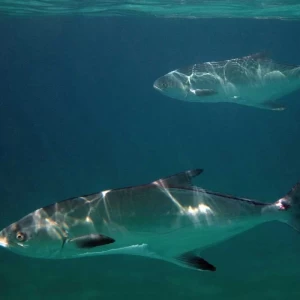Common Names
English: Mangar, Pike Barbel
Turkish: Fırat Turnası, Mangar Balığı
Size
Average Size: 50-100 cm
Maximum Size: Up to 200 cm
Trophy Size: Any size over 80 cm
Scientific Classification
Kingdom: Animalia
Phylum: Chordata
Class: Actinopterygii
Order: Cypriniformes
Family: Cyprinidae
Subfamily: Barbinae
Genus: Luciobarbus
Species: Luciobarbus esocinus
Appearance
Elongated, cylindrical body, somewhat pike-like in shape.
Large mouth with strong jaws.
Coloration is typically silvery or grayish with darker markings.
Distinguishing Features: Pike-like shape, large mouth.
Conservation Status:
Vulnerable (VU)
Endemic to the drainage basins of the Euphrates and Tigris rivers.
Found in large rivers and tributaries, including Keban Dam Lake.
Prefers deep, flowing waters with rocky or gravel substrates.
Distribution: Euphrates and Tigris river basins, Keban Dam Lake.
From its historical significance to its current struggles, the Mangar represents both the beauty and fragility of freshwater ecosystems. By understanding its story, we can appreciate the importance of protecting such unique species for future generations.
The Mangar (Luciobarbus esocinus), also known as the Pike Barbel, is a remarkable ray-finned fish native to the Tigris-Euphrates river system, spanning Iran, Iraq, Syria, and Türkiye. As one of the largest members of the cyprinid family, this ancient species has held cultural significance for millennia, with historical depictions dating back to Assyrian times.
Its pike-like appearance and predatory nature make it a unique and fascinating inhabitant of freshwater ecosystems. Today, the Mangar is celebrated not only for its ecological role but also for its historical legacy, which continues to captivate researchers and anglers alike.
The Mangar thrives in large rivers and reservoirs, often migrating to smaller tributaries for spawning. Its adaptability to various aquatic environments has allowed it to play a key role in the food web, preying on a wide range of aquatic organisms.
However, despite its resilience, the species faces significant challenges. Overfishing and habitat loss have led to a sharp decline in its populations, prompting its classification as Vulnerable by the IUCN. Efforts to study and protect the Mangar are crucial to ensuring its survival in the face of these growing threats.
Regulations and Ban
Regulations may exist due to its vulnerable status.
Overfishing is a significant concern.
Check the most current Turkish inland fisheries regulations for specific details.
Recreational Fishing
This species has become a highly sought-after favorite among recreational anglers, primarily because of its impressive size and the challenging fight it puts up, making it a thrilling and rewarding catch for fishing enthusiasts.
Common fishing methods include casting with large lures or live bait.
Due to overfishing concerns, catch-and-release is strongly encouraged.
Safety: Be aware of strong river currents and the fish’s powerful jaws.
Is Mangar a Game Fish?
Yes
Large and powerful game fish.
Habitat and Distribution
Endemic to the drainage basins of the Euphrates and Tigris rivers.
Found in large rivers and tributaries, including Atatürk and Keban Dam Lakes.
Prefers deep, flowing waters with rocky or gravel substrates.
Distribution: Euphrates and Tigris river basins, Keban Dam Lake.
Ecological Role
Predatory fish, feeding on other fish and large invertebrates.
Diet: Fish, crustaceans, and other large invertebrates.
Best Time to Fish
| Month | Fishing Quality |
|---|---|
| January | Low |
| February | Low |
| March | Moderate |
| April | Good |
| May | Good |
| June | Good |
| July | Moderate |
| August | Moderate |
| September | Moderate |
| October | Moderate |
| November | Low |
| December | Low |
Best Time of Day: Early morning and late evening.
Water Temperature Considerations: More active in warmer months.
Quick Facts
| Common Names (English) | Common Names (Turkish) | Size | Habitat | Conservation Status |
|---|---|---|---|---|
| Mangar, Pike Barbel | Mangar, Fırat Turnası | Up to 150 cm | Euphrates and Tigris Rivers, Keban Lake | Vulnerable (VU) |













